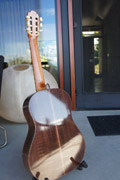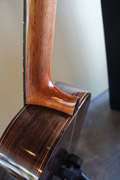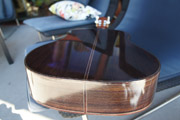|

Englemann spruce top
|
|

East Indian Rosewood Back and sides
|
|

Spanish cedar neck
Englemann spruce top
|

Built from a Hauser 37 plan
|
|

Top braces were all cut from Engelmann spruce brace wood
|
|

picture of my work space in the garage.
|

Back braces are spanish cedar
|
|

Completed Top
|
|

Gluing on the top. This was a bad wayto do it. I should have glued the top in the solera. The neck angle is slight off.
|

No problem gluing on the first back
|
|

continuing clamping on the back
|
|

The guitar top and bottom glued and flush trimmed.
|

This is the first guitar that I used my fancy Luthier tool binding jig. I did
great on the top, but tipped the router on the back. Resulting in a deeper ledge into the back.
|
|

I fixed it up with a facier purfling scheme that worked out OK.
|
|

It was a little hard to keep track of so many bands of wood.
|

All and all gluing on the bindings and purflings went OK
|
|

Note the clamp on the bottom of the guitar, I first clamped on the fretboard without this
clamp and the weight of the clamps pulled the guitar of of the table and crashed to the ground.
|
|

Unfortunatly the back was damaged and I had to remove and replace it.
If I was not so angry I probably could have saved it.
|

I chiseled off the old kerfling and got to repalce it with
AST A4 kerfling
using their fancy clamps.
|
|

I shellaced the inside of the new back.
|
|

Gluing on the new back.
|

This time I used a Steward MacDonald TrueChannel Binding Router Jig to route the binding ledge.
|
|

The binding and purflings channels were cut and the glue up went well. For the frst time I had perfect alignment of the back to the tailgraph. What I am learning is to set things up so the
I can see them when doing any gluing.
|
|

I used my handy dandy centering jig The Simple CenterLine Finder
to set the bridge location. All of the tape is to keep the bridge from sliding as I clamp it on while gluing.
|

Once the clamps were on for about 10 minutes I removed the tap and cleaned up the glue squeeze out.
|
|

Back, sides and neck were pore filled with zpoxy guitar after a wash of Amber shellac this is after the first french polish session.
|
|

Final French polish.
|

Final French polish.
|
|

Final French polish.
|
|

Final French polish.
|
|
|